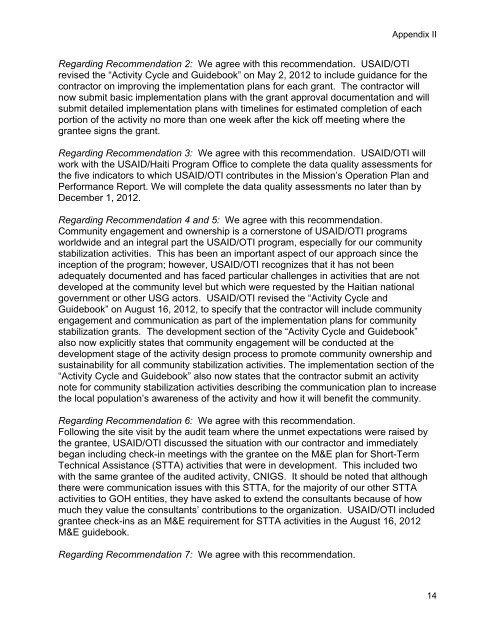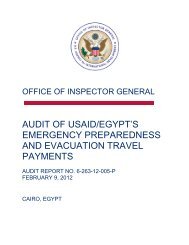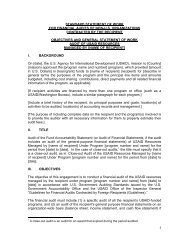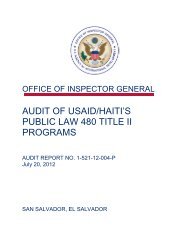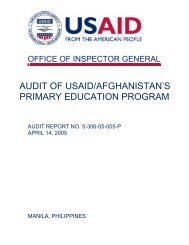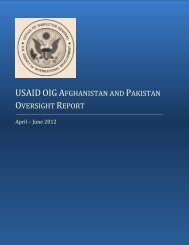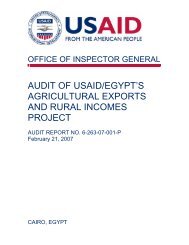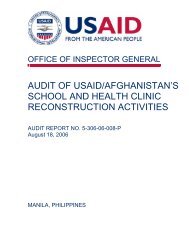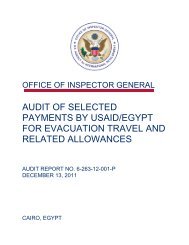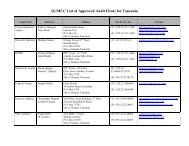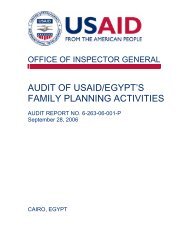Audit of USAID's Haiti Recovery Initiative Activities MAnaged by ...
Audit of USAID's Haiti Recovery Initiative Activities MAnaged by ...
Audit of USAID's Haiti Recovery Initiative Activities MAnaged by ...
You also want an ePaper? Increase the reach of your titles
YUMPU automatically turns print PDFs into web optimized ePapers that Google loves.
Appendix IIRegarding Recommendation 2: We agree with this recommendation. USAID/OTIrevised the “Activity Cycle and Guidebook” on May 2, 2012 to include guidance for thecontractor on improving the implementation plans for each grant. The contractor willnow submit basic implementation plans with the grant approval documentation and willsubmit detailed implementation plans with timelines for estimated completion <strong>of</strong> eachportion <strong>of</strong> the activity no more than one week after the kick <strong>of</strong>f meeting where thegrantee signs the grant.Regarding Recommendation 3: We agree with this recommendation. USAID/OTI willwork with the USAID/<strong>Haiti</strong> Program Office to complete the data quality assessments forthe five indicators to which USAID/OTI contributes in the Mission’s Operation Plan andPerformance Report. We will complete the data quality assessments no later than <strong>by</strong>December 1, 2012.Regarding Recommendation 4 and 5: We agree with this recommendation.Community engagement and ownership is a cornerstone <strong>of</strong> USAID/OTI programsworldwide and an integral part the USAID/OTI program, especially for our communitystabilization activities. This has been an important aspect <strong>of</strong> our approach since theinception <strong>of</strong> the program; however, USAID/OTI recognizes that it has not beenadequately documented and has faced particular challenges in activities that are notdeveloped at the community level but which were requested <strong>by</strong> the <strong>Haiti</strong>an nationalgovernment or other USG actors. USAID/OTI revised the “Activity Cycle andGuidebook” on August 16, 2012, to specify that the contractor will include communityengagement and communication as part <strong>of</strong> the implementation plans for communitystabilization grants. The development section <strong>of</strong> the “Activity Cycle and Guidebook”also now explicitly states that community engagement will be conducted at thedevelopment stage <strong>of</strong> the activity design process to promote community ownership andsustainability for all community stabilization activities. The implementation section <strong>of</strong> the“Activity Cycle and Guidebook” also now states that the contractor submit an activitynote for community stabilization activities describing the communication plan to increasethe local population’s awareness <strong>of</strong> the activity and how it will benefit the community.Regarding Recommendation 6: We agree with this recommendation.Following the site visit <strong>by</strong> the audit team where the unmet expectations were raised <strong>by</strong>the grantee, USAID/OTI discussed the situation with our contractor and immediatelybegan including check-in meetings with the grantee on the M&E plan for Short-TermTechnical Assistance (STTA) activities that were in development. This included twowith the same grantee <strong>of</strong> the audited activity, CNIGS. It should be noted that althoughthere were communication issues with this STTA, for the majority <strong>of</strong> our other STTAactivities to GOH entities, they have asked to extend the consultants because <strong>of</strong> howmuch they value the consultants’ contributions to the organization. USAID/OTI includedgrantee check-ins as an M&E requirement for STTA activities in the August 16, 2012M&E guidebook.Regarding Recommendation 7: We agree with this recommendation.14


